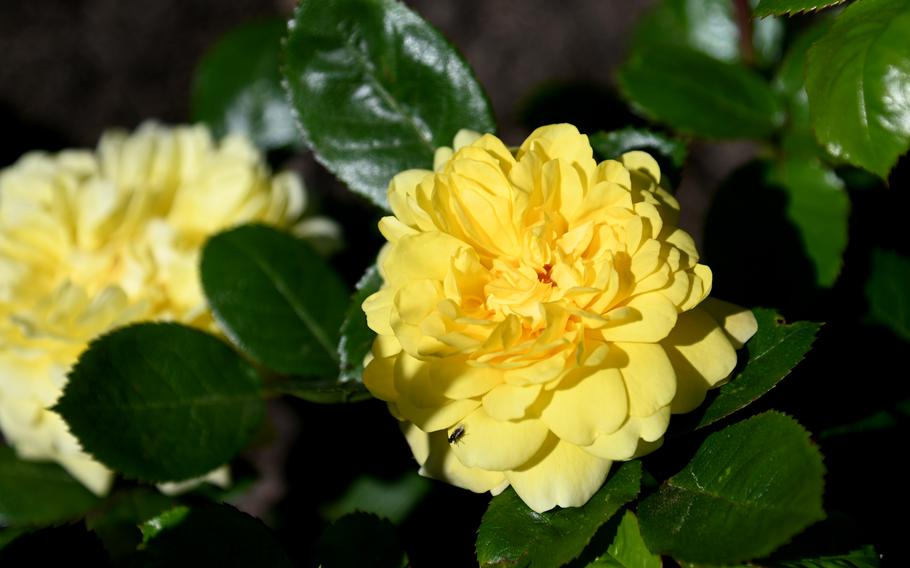
A Yellow Meilove rose was one of the early bloomers at Rosarium at Park Rosenhoehe in Darmstadt, Germany. When in bloom, the roses are the highlight of the park once founded by a grand duchess in the early 19th century. (Michael Abrams/Stars and Stripes)
Mother Nature had fooled us.
With the roses in our yard blossoming, we thought we would take a little trip up to the Rosenhoehe in Darmstadt and check out all the roses blooming there.
But when we got to the park on the east side of this central German city, we found nary a rose in bloom.
True, irises were blooming, as were geraniums in flowerpots. The poppies were shining bright red in the meadows, but only a lone Yellow Meilove rose was flowering in the park’s Rosarium.
It seems nature wasn’t as far along here in the open spaces. But still, there was plenty else to see.
The Rosenhoehe — it means rose height in German — is a landscaped park founded by Grand Duchess Wilhelmine, a member of the house of Hesse-Darmstadt, at the beginning of the 19th century. She used it as her private retreat.
The park has an herb garden, orchards, about 1,500 trees, buildings, artworks. But for most, the main attraction is the Rosarium.
Established by a descendant of Wilhelmine’s, Grand Duke Ernst Ludwig, around 1900, this park within a park features a huge variety of roses laid out in a terraced, geometrical form.
Perennials blossom in between the roses and a pond blooms with water roses and lilies. At the Rosarium’s eastern end is the graceful Rosendom, a wooden cupola that by season’s end is covered with climbing roses.
Unfortunately, the thousands of rosebuds were not yet blooming. Many of the perennials were, and a multitude of frogs croaked among the water roses.
Two sculptures are worth noting here: “Auffliegende Taubenschwarm,” with 17 interlocking doves taking flight, and “Blaetterdach,” an artwork that resembles a forest of trees.
All at the Rosenhoehe is not about beauty, though. Grand Duchess Wilhelmine had what is now the Old Mausoleum built here after the death of her 5-year-old daughter. Later it was expanded and along with the New Mausoleum is the final resting place of many from the house of Hesse-Darmstadt.
While the mausoleums are closed to the public, there are several graves nearby.
The most beautiful is that of Princess Elisabeth, the daughter of Grand Duke Ernst Ludwig by his first wife. It is watched over by a graceful Art Nouveau angel made by artist Ludwig Habich.
Ernst Ludwig lies nearby, as do the five members of his family that were killed in a plane crash on their way to England, a month after his death in 1937.
East of the Rosarium are the orchard meadows with dozens of fruit trees. The meadows between the trees are rarely mowed, leaving a wild habitat for flora and fauna.
On the very eastern end is the Spanish Tower, a small castle-like structure, a folly that no one is sure who built. It is used as an art gallery today.
Next to it is an overlook, with a view of the farms and fields east of the park.
We stopped here to rest before wandering back through the western end of the park with its thick foliage. A great number of trees are planted here, including sequoias, sycamores, ginkgos and Weymouth pines.
At one time — no one is quite certain when — a circle of chestnut trees was planted. Today, it’s a nice place to picnic.
There was once a small palace nearby, the Palais, which was destroyed by Allied bombing in 1944. All that’s left is the ruins of the former main entrance.
We walked out of the park the way we came in, through the imposing Loewentor, or Lions Gate. Originally built for the nearby artists colony in 1914, it features six pillars topped by six stone lions.
After a nice morning of fresh air, we retreated to our yard to admire our blooming roses, knowing we would eventually return to the Rosenhoehe and see the Rosarium in full bloom.
abrams.mike@stripes.com; Twitter: @stripes_photog
Directions: The Rosenhoehe is on the eastern edge of Darmstadt. The Lions’ Gate (Loewentor) is just off Wolfskehlstrasse, where there is some parking. If you arrive in Darmstadt by train, take the F bus from the main station to the Spessartring stop then walk down Wolfskehlstrasse.
Times: Open daily, all day.
Costs: Free
Food: Nothing at the park. Bring a picnic basket. In the summer, the Biergarten is nearby on the corner of Spessartring and Dieburgerstrasse. Closed Mondays, opens at 3 p.m. Tuesday through Saturday, noon on Sundays.
Info: Online: park-rosenhoehe.info. There is an English-language button on the site.